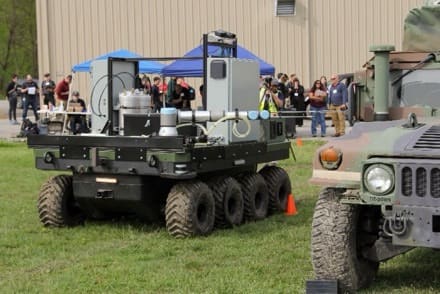Aberdeen Proving Ground, MD — The best way to find out if a new car is right for you is to take it for a spin. When it comes to a new way to decontaminate military vehicles using mobile robotic technology, the same holds true. Take a seat at the computer, operate the system’s remote controls and see what feels right and what doesn’t.

That is exactly what four Soldiers from the U.S. Army’s 1st Armored Division did at this year’s Maneuver Support and Protection Integration eXperiments event, or MSPIX, held at Fort Leonard Wood, Missouri, May 6 to 23. The robotic system they were operating was the U.S. Army Combat Capabilities Development Command Chemical Biological Center’s (DEVCOM CBC) Autonomous Equipment Decontamination System.
The Soldiers were excited. “This system takes us away from the threat completely, and its buttons and controls are easy to use,” said Spc. Yaleidi Escalera. “We are the ones who will be using it in the fight, so it feels good to be able to tell the technology developers exactly what we need now.”
Escalera and three other CBRN Soldiers spent four days operating the system, followed by face-to-face feedback with the technology development team on what they liked about it and what parts of it can be improved.
“We usually never get a chance to meet the people designing the instruments we’re using as Soldiers,” said Sgt. First Class Joseph Bennett, also of First Armored. “So getting to experience the brain behind the equipment was exciting. They’re coming to us and asking, ‘Is this what you really want,’ and we get to tell them what we think.”
The Autonomous Equipment Decontamination System consists of a camera mounted on an unmanned ground vehicle (UGV). The camera scans the entire vehicle surface as it circles around it, transmitting the contamination data back to the system operators seated at a computer safely in the rear. A robotic manipulator arm then uses that data to spray a decontamination slurry developed by DEVCOM CBC on only those chemical agent hotspots, conserving decontaminant and saving time.
The Autonomous Equipment Decontamination System team received valuable feedback that they will use to refine the technology. The Soldiers pointed out the challenges encountered by the robotic platform while navigating around and manipulating the odd shapes and hard to reach surfaces of some military vehicles. The Soldiers also noticed simple things, such as adding right click functionality to the mouse on the computer interface to add more user capability. Finally, the Soldiers wanted to have a manual override for the applicator arm in case they find that not all the hot spots are being reached in autonomous mode.
Autonomous Equipment Decontamination is a multi-year cooperative project led by DEVCOM CBC. In addition to DEVCOM Army Research Laboratory support in designing the system’s robotic arm, DEVCOM Ground Vehicle Systems Center supports the computer interface and UGV operations. Industry partner Teledyne FLIR supports the development of software for the system’s camera.
Currently, it takes a team of 20 to 30 Soldiers in full protective gear 45 to 60 minutes to decontaminate each vehicle exposed to chemical or biological hazards. Soldiers must perform this task close to the point of exposure and may be vulnerable to enemy fire. The process takes more than 500 gallons of water and 50 gallons of decontaminant per vehicle.
Warfighter feedback is the acid test for a technology initiative according to Maj. Paul Austin, a CBRN experimental officer with the Maneuver Support Battle Lab who coordinates and runs MSPIX. “I know from my experience as a CBRN officer during my time in the Special Operations Command the value of fast, efficient decontamination in the field,” said Austin. “Chemical and biological agents are a weapon that can severely disrupt an operation, so being able to quickly address it is essential to completing the mission.”
Story by Brian Feeney, U.S. Army Combat Capabilities Development Command Chemical Biological Center


“test drive” “autonomous” . . . ? 🙂
that’s like batteries for a sound-powered phone, or towing a self-propelled howitzer. 🙂